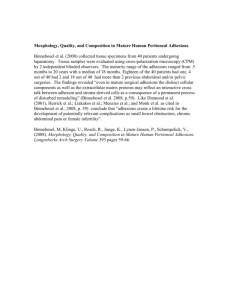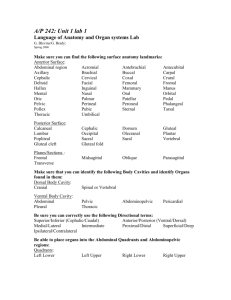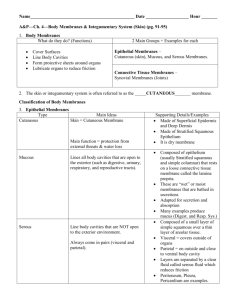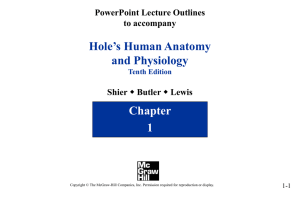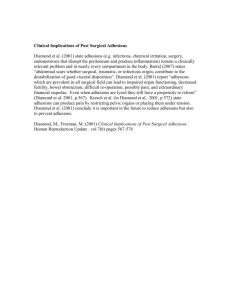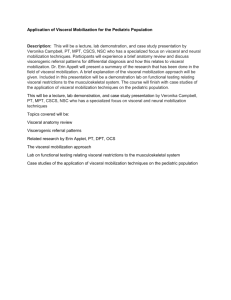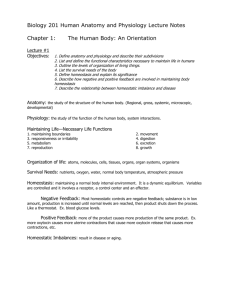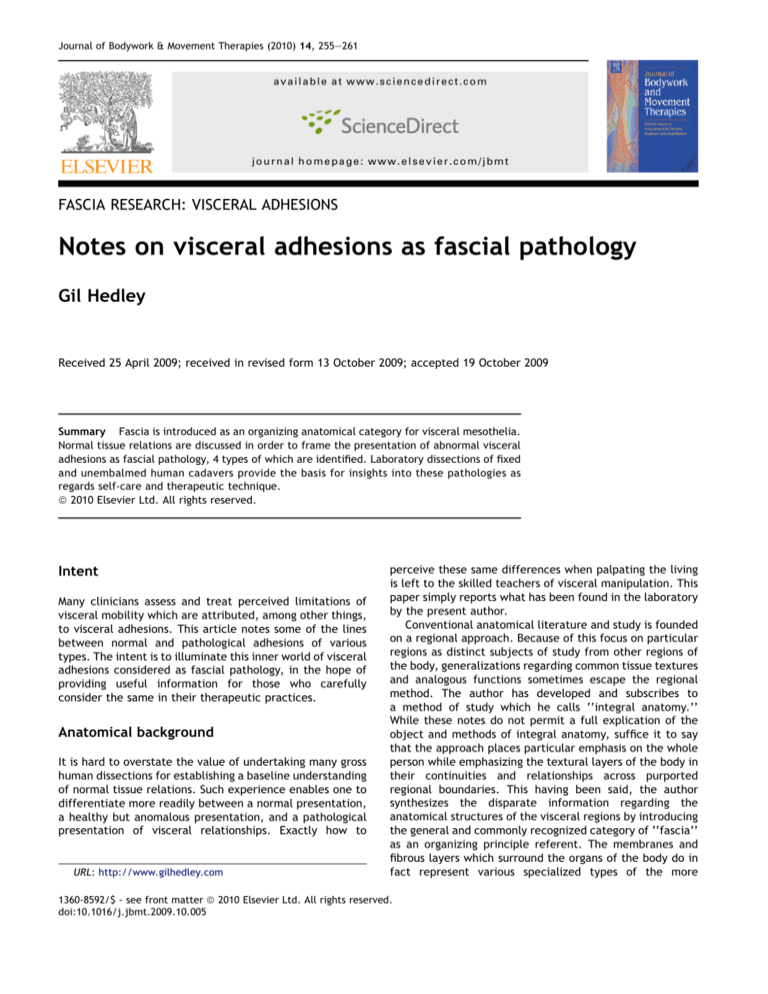
Journal of Bodywork & Movement Therapies (2010) 14, 255e261
available at www.sciencedirect.com
journal homepage: www.elsevier.com/jbmt
FASCIA RESEARCH: VISCERAL ADHESIONS
Notes on visceral adhesions as fascial pathology
Gil Hedley
Received 25 April 2009; received in revised form 13 October 2009; accepted 19 October 2009
Summary Fascia is introduced as an organizing anatomical category for visceral mesothelia.
Normal tissue relations are discussed in order to frame the presentation of abnormal visceral
adhesions as fascial pathology, 4 types of which are identified. Laboratory dissections of fixed
and unembalmed human cadavers provide the basis for insights into these pathologies as
regards self-care and therapeutic technique.
ª 2010 Elsevier Ltd. All rights reserved.
Intent
Many clinicians assess and treat perceived limitations of
visceral mobility which are attributed, among other things,
to visceral adhesions. This article notes some of the lines
between normal and pathological adhesions of various
types. The intent is to illuminate this inner world of visceral
adhesions considered as fascial pathology, in the hope of
providing useful information for those who carefully
consider the same in their therapeutic practices.
Anatomical background
It is hard to overstate the value of undertaking many gross
human dissections for establishing a baseline understanding
of normal tissue relations. Such experience enables one to
differentiate more readily between a normal presentation,
a healthy but anomalous presentation, and a pathological
presentation of visceral relationships. Exactly how to
URL: http://www.gilhedley.com
perceive these same differences when palpating the living
is left to the skilled teachers of visceral manipulation. This
paper simply reports what has been found in the laboratory
by the present author.
Conventional anatomical literature and study is founded
on a regional approach. Because of this focus on particular
regions as distinct subjects of study from other regions of
the body, generalizations regarding common tissue textures
and analogous functions sometimes escape the regional
method. The author has developed and subscribes to
a method of study which he calls ‘‘integral anatomy.’’
While these notes do not permit a full explication of the
object and methods of integral anatomy, suffice it to say
that the approach places particular emphasis on the whole
person while emphasizing the textural layers of the body in
their continuities and relationships across purported
regional boundaries. This having been said, the author
synthesizes the disparate information regarding the
anatomical structures of the visceral regions by introducing
the general and commonly recognized category of ‘‘fascia’’
as an organizing principle referent. The membranes and
fibrous layers which surround the organs of the body do in
fact represent various specialized types of the more
1360-8592/$ - see front matter ª 2010 Elsevier Ltd. All rights reserved.
doi:10.1016/j.jbmt.2009.10.005
256
G. Hedley
general category of ‘‘fascia,’’ the general properties and
anatomy of which this author gives a more thorough
accounting elsewhere (Hedley, 2005a,b, 2006, 2009). In
that prior resource is introduced the notion of ‘‘visceral
fasciae.’’ According to this account, the notion of ‘‘visceral
fasciae’’ is observed to include, in a manner that repeats
across regions, a fibrous outermost layer, a parietal serous
layer, and a visceral serous layer. Careful and considerate
attention to these tissues is given by Barral in his several
volumes of work, upon which the present author relies,
especially in so far as they provided foci of interest for
more direct explorations in the laboratory. (Barral and
Mercier, 1988; Barral, 1989,1991,1993) In order simply to
convey from an integral perspective the various structures,
already known and identified in a disparate manner through
the conventional regional approach, the author developed
Table 1. (Hedley, Vol. 3, 2006.) In Table 1, a schematization
of the various structures by region is offered, including the
membranes of the CNS for the sake of analogical
completeness, in a manner that organizes them according
to analogous tissue textures.
Normal adhesion of the parietal layer to the
fibrous layer
It is the author’s experience that it is normal for the parietal, or ‘‘wall’’ layer, to be adherent to the outermost
fibrous layer. The parietal serous membranes are relatively
well fixed to the fibrous layer in normal tissue presentations,
though they can be manually ‘‘peeled’’ apart and thus
differentiated in gross dissection in a manner which clearly
demonstrates the distinctness of the two layers. The degree
to which the parietal layer is fixed is somewhat predictable
based on region. The parietal peritoneum, for instance, is
considerably more firmly fixed with fibers at the anterior
midline to the transversalis fascia than it is more lateral to
this line. The two layers can be peeled apart manually along
most of their shared surface, but at the midline a scalpel is
required to differentiate them (Photo 1).
Normal adhesion of the visceral layer to the
viscera
It is also the author’s experience that it is normal for the
visceral layer of serous membrane to be adherent to the
underlying parenchymal tissues of the given organ which it
covers. Because of their complete adherence to the tissue
of the organs they cover, this author refers to the visceral
serous membrane as the ‘‘skin’’ of the organ. The pelvic
‘‘space’’ is technically sub-peritoneal and outside of this
Table 1
Photo #1 Above, we see the entire parietal peritoneum
presenting after the more superficial transversalis fascia has
been differentiated and reflected superiorly. The visibly
yellowish midline tissues represent the normal locus of higher
degrees of normal fibrous fixation to the overlying transversalis
fascia. Image Copyright Gil Hedley, 2006. Used with permission.
typology. For the sake of anatomical accuracy then, it
should be said that the rectum, uterus and bladder are all
invested/covered superiorly by parietal rather than visceral
peritoneum (Photo 2).
Proceeding from the deep aspect of the visceral layer of
the serous membrane, there are fibers that are continuous
with the connective tissue matrix of the underlying tissues.
Therefore the ‘‘skin’’ of an organ, despite its obvious
continuity as a fascial ‘‘wrap,’’ cannot be very readily
‘‘peeled’’ from the enveloped organ itself, with which it
exists in perfect continuity. The visceral serous membranes
rather shred when an attempt is made to differentiate
them, much as the periosteum does, when the deeper
connections are severed and the thin fabric of the surfacing
layer recoils upon itself. In this manner then, the degree of
normal ‘‘adhesion’’ of the visceral serous membrane to the
organ exceeds the tenacity of the relationship of the fibrous
outermost layer and the parietal serous layer, whether
pleural, pericardial or peritoneal.
The pia mater of the central nervous system is the least
substantial as compared to its visceral membranous fascial
analogues. It does not manifest enough depth in itself, or
enough fibrous matter, being only a two or three cell-deep
covering over the brain, even to ‘‘shred’’ in the fashion of
the visceral pleura, for instance. It is soft enough to easily
push a finger through, which is not the case for the visceral
layer of the serous membranes in general. The pia simply
cannot be differentiated as a layer except histologically.
Schematization of cranial and visceral fasciae.
Visceral Spaces
Fibrous outermost layers
Parietal serous layers
Visceral serous layers
Intracranial
Thoracic
Cardiac
Abdominal
Dura mater
Endothoracic fascia
Fibrous pericardium
Transversalis fascia
Arachnoid
Parietal pleura
Parietal pericardium
Parietal peritoneum
Pia
Visceral pleura
Visceral pericardium
Visceral peritoneum
Table 1 is taken from The Integral Anatomy Series, Vol. 3: Cranial and Visceral Fasciae, Copyright Gil Hedley, 2006, on DVD. Used with
permission.
Fascia research: Visceral adhesions
257
Adhesion distinguished from ligamentous
distortion
Photo #2 Above we see the visceral peritoneum covering the
hepatic flexure of the colon. Image Copyright Gil Hedley, 2009.
Used with permission.
Normal relations of parietal and visceral layers
to each other
The parietal and visceral layers of the various serous
membranes form a continuity of tissue: the fascia is
continuous, but it reflects off of the organs and then
doubles-back around them to form an enveloping
‘‘balloon’’ around them as well. (Gray, pp. 459, 901, 970,
1901/1977) Within the parietal layer, then, the viscera,
themselves covered in their ‘‘skins,’’ ideally slide one
against another in perpetual motion in their ranges of
normal mobility. They also slide against the parietal layer
which surrounds them and with which they have varying
degrees of contact throughout their range of motion.
Further, in certain areas, the parietal layer is in sliding
contact with itself.
Normal sliding surfaces
So normal sliding surfaces can be said to include visceral
serous membranes against one another, parietal serous
membranes against themselves, and finally visceral serous
membranes against parietal serous membranes. A few
examples of these three categories of sliding surfaces are
schematized in Table 2.
Definition of pathological adhesion
A pathological adhesion, for the purposes of this conversation, is defined as a fixed connection between tissues
which would normally slide relative to each other. Such
adhesions are ‘‘pathological’’ to the extent that the normal
range of motion of the tissues is inhibited by the abnormal
relations of the visceral fascia. The normal motion of the
organs in their own right, as well as in their relationships
with one another, are an essential aspect of the proper
physiological functioning of the organs. Therefore the
disruption of normal motion via fascial pathology in the
form of adhesions is potentially disruptive of highest organ
function (Photo 3).
An adhesion is distinguished by the author for the purposes
of these notes from the phenomena of distortions of
visceral ligaments. ‘‘Ligaments’’ in anatomical nomenclature most generally indicate literally a form of ‘‘tying’’ of
one structure to another. (from Latin, ligare, to bind or tie)
Ligaments ‘‘tie’’ bone to bone, but they also ‘‘tie’’ organ to
organ, and so on. Visceral ‘‘ties,’’ or ligaments, most often
consist of various reflections, folds and spannings of the
serous membranes (mesothelia) as they envelop the
complex but interrelated forms of the viscera themselves
and the convolutions of the spaces wherein the viscera
move. In the author’s experience, the serous membranes
are found to be highly elastic, which property is demonstrable not only in unfixed but also in fixed tissue samples,
evidenced insofar as they recoil in various degrees when
incised. The elastic property derives anatomically from the
ample presence of both simply elastic as well as actively
contractile fibers within the membranes. (Schleip, 2006,
p.3) The causes of tissue shortening are various and beyond
the scope of the present article. It is sufficient for now to
simply distinguish for conversation’s sake between adhesions, where normal sliding surfaces are stuck to one
another, and ligamentous distortion, where abnormal
shortening or lengthening of the relationships of organs
through their various ‘‘tyings’’ represent a different kind of
fascial pathology of the viscera.
Types of pathological adhesion by cause
Table 2, therefore, can serve equally well to outline
potential loci of adhesions, because any normal sliding
surface contacts also have the potential to become stuck:
that is, to adhere, to one another. It is the author’s
observation of clinical evidence in the laboratory that the
circumstances which give rise to the adhesion of normally
sliding surfaces are multiple. They include, but are not
exhausted by, the following causes:
1) inflammation from infections or other types of disease
processes
2) inflammation and scarring as the sequelae of surgical
intervention
3) the sequelae of prior limitations upon movement cycles
4) intentional therapeutic adhesion
Inflammation from infections or other types of
disease processes
Serous membranes, like other tissues of the body, being
highly vascular and innervated, are subject to inflammation
from a variety of causes. Any ‘‘-itis’’ in the region of the
viscera could potentially, though not necessarily, result in an
adhesion. For instance, a lung infection could result in one or
more points of fibrous connection of varying degrees of
density between the visceral and parietal pleura. Pericarditis may result in a broad fixation of the visceral and parietal
258
Table 2
G. Hedley
Examples of normal sliding surfaces.
Visceral layers against each other
Parietal layers against themselves
Visceral layers against parietal layers
Stomach to liver
Diaphragmatic aspect of parietal pleura
to costal aspect of parietal pleura
Diaphragmatic aspect of parietal pleura to
mediastinal aspect of parietal pleura
Uterus to rectum
Visceral pleura to parietal
pleura
Visceral pericardium to parietal
pericardium
Visceral peritoneum to parietal
peritoneum
Loops of small intestine to
themselves
Ovaries to loops of small
intestines
Table 2 Copyright Gil Hedley, 2009.
Used with permission.
pericardium. The normally free border of a cystic ovary may
become adherent to the adjacent parietal peritoneum of the
posterior abdominal wall (Monk et al., 1994). The author
regularly dissects these types of ovarian adhesions as they
appear commonly in cadaver specimens (Photo 4).
This author has directly observed in the laboratory how
other disease processes can result in adhesions beyond those
deriving from straightforward inflammatory processes. Cysts
and tumors can have the effect of binding two organs or two
sliding surfaces together with the aberrant growth serving as
the focal point of adhesion between the membranes. Ulcers,
cancerous metastases and pancreatitis exemplify more
extreme types of inflammation where strong adhesions may
result from the disruption of the local tissues (Troitskii, 1968).
Inflammation and scarring as the sequelae of
surgical intervention
Surgery offers so many advantages that we are prone to
forgive some of the problems that it can cause, among which
can be counted visceral adhesions, and scarring. Where
there are surgical scars observed on the outside of a human
form, one can almost unerringly predict some manifestation
of adhesions and scarring within the form. Scarring is defined
by this author, for the sake of this discussion and based on
Photo #3 Arrow identify the adhesion of the visceral peritoneum of the small intestine to the parietal peritoneum of the
ascending colon: these normally have a sliding relationship
with each other. Image Copyright Gil Hedley, 2009. Used with
permission.
direct observation, as aggregations of fibrous matter that
result when surgical incisions or other types of wounds heal,
leaving tissue layers (skin, superficial fascia, deep fascia,
and membranes) pinned to each other with reduced play and
elasticity. This author has also observed how the fiber
direction of scars so defined is usually plaited in a multidirection manner, distorting the normal vectors of elasticity
and tension native to the tissue. Scars can also be evident
within the visceral spaces wherever incisions have been
made, and in these cases they sometimes have as sequelae
the adhesion of local tissues. (Zong et al., 2004) For instance,
this author has directly observed how open heart surgeries
will often result in major adhesions of the left lung to the
chest wall, i.e., the visceral to the parietal pleura, as well as
considerable adhesion of the visceral to the parietal pericardium. Because the incisions of surgery necessarily cause
inflammation of the local tissues, in combination with scarring this can result in the formation of a seemingly progressive adhesion of visceral fasciae (Liakakos et al., 2001)
(Photos 5 and 6).
The sequelae of prior limitations upon
movement cycles
Visceral ligaments and the spatial relationship of the organs
to one another define the normal range of motion of the
Photo #4 Above the arrows indicate the whole inferior
margin of the liver adherent to the greater omentum as the
likely sequela of inflammatory processes. Image Copyright Gil
Hedley, 2009. Used with permission.
Fascia research: Visceral adhesions
259
subsequent irritation of the membranes will initiate the
formation of adhesions between the membranes which
when fully progressed will have the effect of mitigating
further collapse: the adherent membranes serve to sustain
the inflation of the lung. (Montes et al., 2006) The loss of
the sliding surface between the visceral and parietal pleura
is the price willingly paid for the higher good of the lung’s
permanent inflation. This author has directly observed how
surgeons will suture tissues together in a manner
demanding fixed relationships of tissues which might
otherwise prolapse or spread apart. Thus sometimes tissues
are adherent because it is demanded of them to be so
(Wong and King, 2004).
Varying impact of adhesions
Photo #5 Adhesions of visceral to parietal pericardium
following upon open heart surgery. Image Copyright Gil Hedley,
2006. Used with permission.
viscera as they respond to the breath cycle. A scar or initial
adhesion represents an abnormal limit cycle upon the
phases of movement characteristic within the visceral
spaces. It is this limitation of movement which is at the
heart of the type of progressive adhesion noted above.
Adhesions beget adhesions, as the initial limitation of
normal motion extends like a growing cloud of stillness in
the immediate tissues. This type of progressive adhesion
will form as a diffused and general fixed relationship of the
tissues across a broad surface, rather than as a cluster of
single-pointed fibrous linkages. In dissection, one ‘‘peels’’
these adhesions apart, as opposed to cutting or ‘‘popping’’
them at individual points of relationship. The author has
dissected many human forms where numerous precedent
abdominal surgeries have resulted in virtually the entire
visceral contents becoming adhered into a single common
mass (Photos 7 and 8).
Intentional therapeutic adhesion
The adhesion of normally sliding surfaces in any of the
manners described range on a continuum of impact upon
normal organ function from inconsequential to debilitating.
Where the abdominal organs are reduced to a virtually solid
and immobilized mass as a result of repeated major surgical
interventions, the physiology of the organs are necessarily
affected by their lack of mobility over time. On the other
hand, a minor and singular adhesion of a fatty epiploic
apendage of the descending colon to the adjacent parietal
peritoneum is unlikely to have any particularly untoward
effect, given the normally relatively fixed position of the
colon along the posterior wall of the abdomen by the
parietal peritoneum (Photo 9).
Palpating for adhesions
Part of the process of careful dissection of the viscera
involves visually observing and manually palpating the
tissues. This inspection process often reveals a variety of
adhesions in the mostly elderly forms which donor programs
provide. Often it is possible to deduce or infer the causes of
the adhesions based on the evidence at hand, and given
a lack of explicit medical history, these inferences are all
In the instance of a repeatedly collapsing lung, talc may be
introduced between the visceral and parietal pleura. The
Photo #6 After the removal of the adhesions of the visceral
and the parietal pericardium shown above. Image Copyright Gil
Hedley, 2006 used with permission.
Photo #7 Above is a specific fibrous adhesion of the visceral
pleura of the right lung at its most inferior tip, to the parietal
pleura in its mediastinal aspect. Image Copyright Gil Hedley,
2009. Used with permission.
260
Photo #8 Above a progressive adhesion of the entire visceral
surface of the lung to the mediastinal pleura is being manually
peeled apart in dissection: the arrows indicate the still undifferentiated adhesions at the margins of the lung. Image
Copyright Gil Hedley, 2009. Used with permission.
there is to go by. Many of the adhesions discovered, when
not obviously associated with evident disease processes or
surgical interventions, would likely have escaped the
knowledge of the donors and their doctors. Nonetheless,
they may have been subtly affecting optimal visceral
motion and health. The question then remains open as to
how a therapist trained in visceral manipulation might
facilitate the visceral motion in the living in a manner that
might relieve some of the adhesions revealed in the
dissection process.
Direct vs indirect approaches to releasing
adhesions
In the process of differentiating the viscera it becomes
necessary to release adhesions as they are found. Many
G. Hedley
adhesions can simply be directly pulled apart manually in
dissection. The author has often imagined that the same
could probably have been accomplished manually in vivo as
well, given the appropriate leveraging of the tissues in
question. However, though this type of direct technique
seems possible, it does not, upon careful consideration,
appear to be the most advisable approach. Fibrous adhesions when broken abruptly can result in small wounds to
the tissues related by them, which wounds themselves
would be likely sources of inflammation. So a cycle of
adhesion could easily be re-introduced with such a strategy,
creating little progress, or even exacerbating the problem.
A more indirect technique for releasing adhesions in vivo
would appear to be desirable. By manually facilitating
movement towards the normal range of motion of the fixed
tissues with gentle traction, timed with several fulsome
breath cycles on the part of the client, the expanding range
of motion may itself induce the dissolution of the adhesions, not necessarily in the moment, but over time. In the
same way that restrictions upon movement from adhesions
may progress into greater levels of adhesion over time,
enhancements of movement may progress into greater
levels of movement and the restoration of normal sliding
relationships of tissues.
Hypothetical examples of indirect release of
adhesions in vivo
These examples are hypothetical and are not meant to
serve as medical advice. They could serve as sample
protocols for researching the impact of interventions with
respect to post surgical adhesions.
Self-care example
An individual might help themselves to release adhesions
from progressing after thoracic surgery with a practice of
simple variations on thoracic twists. For instance, with
hands grasping on a pull-up bar positioned at a height
within easy reach, an individual could introduce gentle
torques into their thorax, accompanied by several deep
breath cycles at each position explored. Such could be
a daily practice for a few minutes a day post-surgery. The
external torsion accompanying the internal breath could
literally stretch and mobilize fixed but normally sliding
tissues of the thorax. The reiteration of larger cycles of
motion thus introduced could have the effect over time of
gently dissolving adhesions, slowing the progression
of further adhesion, or at least increasing the elasticity and
range of motion of the individual’s visceral relationships,
both normal and pathological.
Practitioner-supported example
Photo #9 Epiploic appendage of descending colon adhering
to parietal peritoneum. Image Copyright 2009 Gil Hedley. Used
with permission.
In instances where the support of a practitioner is warranted, taking the same example as above, a trained
bodywork practitioner could gently introduce torsions into
the patients thorax while coaching their position and
breath cycles, with an intent on varying the presenting
Fascia research: Visceral adhesions
motion patterns which may be reflecting underlying adhesions. By increasing the factors which thus increase demand
for the gliding of sliding surfaces which may be fixed,
greater movement cycles may reiterate and accrue to the
advantage of the client in the manner described above.
References
Barral, J.-P., Mercier, P., 1988. Visceral Manipulation. Eastland
Press, Seattle.
Barral, J.-P., 1989. Visceral Manipulation II. Eastland Press, Seattle.
Barral, J.-P., 1991. The Thorax. Eastland Press, Seattle.
Barral, J.-P., 1993. Urogenital Manipulation. Eastland Press, Seattle.
Gray, Henry, 1901/1977. Anatomy, Descriptive and Surgical.
Gramercy Books, New Jersey.
Hedley, G., 2005a. The Integral Anatomy Series, on DVD. In: Skin
and Superficial Fascia, vol. 1.
Hedley, G., 2005b. The Integral Anatomy Series, on DVD. In: Deep
Fascia and Muscle, vol. 2.
Hedley, G., 2006. The Integral Anatomy Series, on DVD. In: Cranial
and Visceral Fasciae, vol. 3.
261
Hedley, G,, 2009. The Integral Anatomy Series, on DVD Viscera and
their Fasciae.
Liakakos, T., Thomakos, N., Fine, P.M., Dervenis, C., Young, R.L.,
2001. Peritoneal adhesions: etiology, pathophysiology, and
clinical Significance. Dig. Surg. 18, 260e273. PMID 11528133.
Monk, Bradley J, Berman, Michael L, Montz, F.J., 1994 May.
Adhesions after extensive gynecologic surgery: clinical significance, etiology, and prevention. Am. J. Obstet. Gynecol. 170
(5), 1396e1403.
Montes, J.F., Garcı́a-Valero, J., Ferrer, J., 2006 Sept. Evidence of
innervation in talc-induced pleural adhesions. Chest 130 (3),
702e709. PMID: 16963666.
Schleip, R., 2006, Active Fascial Contractility. Implications for Musculoskeletal Mechanics, Dissertation, Ulm University, Ulm, Germany.
Troitskii, R.A., 1968 April. Abdominal adhesions and tumor growth.
Bull. Exp. Biol. Med. 65 (4), 441e443.
Wong, S.W., King, D., 2004 Aug. Sutureless intestinal plication. ANZ
J. Surg. 74 (8), 681e683.
Zong, Xinhua, et al., 2004. Prevention of Postsurgery-induced
abdominal adhesions by electrospun bioabsorbable nanofibrous
poly(lactide-co-glycolide)-based membranes. Ann. Surg. 240
(5), 910e915. 2004 Nov.PMID: PMC1356499.

